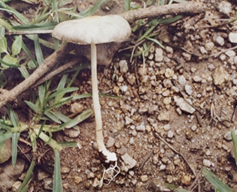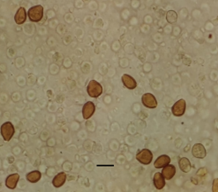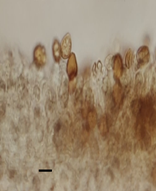Bolbitius vitellinus (Pers.) Fr. in Epicrisis Systematis Mycologici 254, 1838. Fig.9
MycoBank number: MB 153925; Index Fungorum number: IF 153925; Facesoffungi number: FoF 10774;
Basionym – Agaricus vitellinus Pers. in Synopsis Methodica Fungorum p. 402, 1801.
Synonyms – Pluteolus vitellinus (Pers.) Quél. in Flore Mycol. de France p. 83, 1888. Cortinarius vitellinus (Fr.) Bigeard & H. Guill. in La Flore des Champignons supérieur de France, 1: 255, 1909.
Bolbitius vitellinus subsp. fragilis (Fr.) Konr. & Maubl. in Icon. Sel. Fung. 2: 171, 1930. Bolbitius titubans var. vitellinus (Pers.) Courtec. in Doc. Mycol. 34(135–136): 49, 2008.
Pileus 2.0 – 6.0 cm in diameter, conico-campanulate then expanding to plane, surface yellowish- brown ,umbonate with a broad umbo, golden- yellow at the disk, paling towards the margin, surface viscid, cap fragile, with striate margin , flesh thin and smooth. Stipe length 4.0 – 11.0 cm × 0.2 – 0.5 cm in diameter, central, cylindric elongated, or slightly attenuated towards the apex, fistulose, cartilaginous and brittle, white to straw colored, glabrescent below but villose at the base, often with basal mycelial strands. Lamellae brown to ochraceous- brown, bruising to dark- brown, free, thin, moderately crowded, edge wavy and white. Spores 10.0 – 12.0 × 6.0 – 8.0µm, ovoid to ellipsoid, with a distinct apical germ pore, ochre brown to rust brown, possessing a smooth wall . Basidia 4-spored, clavate in shape. Lamellae edge heteromorphous with numerous cheilocystidia which are clavate thin–walled, and hyaline but granular near the tips. Pleurocystidia absent.
Ecology and distribution– B. vitellinus is a coprophilous macrofungi with world-wide distribution. ———–. It has been reported by Pegler (1977) from East Africa, ———————————————-. From India, it has been reported from Punjab by Amandeep et al. 2013 growing on dung heaps, and by Bilgrami et al. 1991, Saini & Atri 1995, Natarajan et al. 2005, Manimohan et al. 2007, Atri et al. 2009, Mohanan 2011. In the present communication also, it has been found growing on dung and manured soil in pasturelands.
Specimens Examined – JNV/Mycl/ 1032/2018, by Reenu Chouhan, 24°53’18.17″N72°50’52.58″E Sirohi, elevation:321 m (1,053 ft), Mount Abu 72.7083°E 24.5925°N Toad rock area.
Note: The macroscopic and microscopic details of the above examined collection are in close agreement with the taxonomic details of B. vitellinus as given by Singer (1977 and Pegler (1977).

a

b

c
Fig.9 a Fruiting body of Bolbitius vitellinus. b Spores. c. Hymenium layer with basidia and spores. Scale bar: b = 10 µm, c = 15 µm
